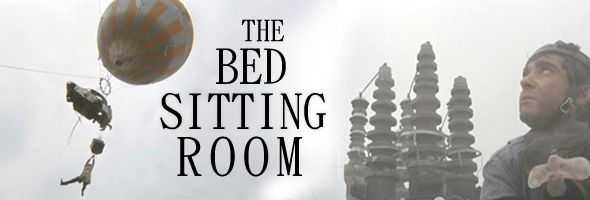

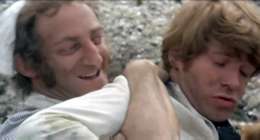 After England has been decimated by a nuclear war, twenty survivors mill about the desolate, debris-strewn wasteland performing twisted variations on their normal daily rituals. The BBC still exists thanks to a newscaster (Thornton) who stands in front of a blown-out TV set offering background exposition, and many of the survivors are either mutating into furniture or animals or being told they're dead even when they clearly aren't. Among these lost souls going mad are a pregnant teen (Tushingham) endlessly riding an underground train with her family, a lunatic nurse (Feldman), a lord afraid he's transforming into the titular bed sitting room (Richardson), two airborne police officers (Moore and Cook), and a lone mailman (Milligan, who co-authored the source play with John Antrobus). Their fates intertwine in a series of darkly comic sketches which pile on top of each other in front of increasingly surreal vistas, including a mostly submerged cathedral and the climactic transformations of several key characters.
After England has been decimated by a nuclear war, twenty survivors mill about the desolate, debris-strewn wasteland performing twisted variations on their normal daily rituals. The BBC still exists thanks to a newscaster (Thornton) who stands in front of a blown-out TV set offering background exposition, and many of the survivors are either mutating into furniture or animals or being told they're dead even when they clearly aren't. Among these lost souls going mad are a pregnant teen (Tushingham) endlessly riding an underground train with her family, a lunatic nurse (Feldman), a lord afraid he's transforming into the titular bed sitting room (Richardson), two airborne police officers (Moore and Cook), and a lone mailman (Milligan, who co-authored the source play with John Antrobus). Their fates intertwine in a series of darkly comic sketches which pile on top of each other in front of increasingly surreal vistas, including a mostly submerged cathedral and the climactic transformations of several key characters. 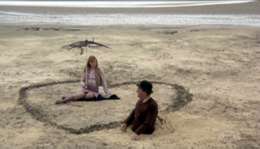 It's a shame midnight movies didn't really catch on until the early '70s, as Richard Lester's absurdly ahead-of-its-time The Bed-Sitting Room seems perfectly pitched for late night audiences. Absurdist humor with a pitch-black complexion rules this post-nuclear gallery of characters, featuring a host of terrific British performers. Critics at the time were confounded and hardly amused by this depiction of a fallout-laden society where mutation and death linger in many of the punch lines, an approach later picked up to much greater acclaim in the U.S. with A Boy and His Dog. Unfortunately Lester, a hot property at the time thanks to A Hard Day's Night and The Knack, suffered a serious career setback from which he didn't recover until years later with The Three Musketeers and the underrated Juggernaut.
Incredibly shot by the talented David Watkin (who used a similar visual approach later on Ken Russell's The Devils), this film will be a severe eye-opener for fans of another expatriate American director, Terry Gilliam, whose Brazil and Time Bandits owe a particular debt to this aesthetic approach of this film. Its status as a forerunner to Monty Python is valid as well, particularly the random, "realistic" absurdity of Monty Python and the Holy Grail, while the presence of Beyond the Fringe vets Cook and Moore (the hottest comedy duo in the UK at the time, fresh off of Stanley Donen's classic Bedazzled) forms a nice link between two generations of comedy as well.
It's a shame midnight movies didn't really catch on until the early '70s, as Richard Lester's absurdly ahead-of-its-time The Bed-Sitting Room seems perfectly pitched for late night audiences. Absurdist humor with a pitch-black complexion rules this post-nuclear gallery of characters, featuring a host of terrific British performers. Critics at the time were confounded and hardly amused by this depiction of a fallout-laden society where mutation and death linger in many of the punch lines, an approach later picked up to much greater acclaim in the U.S. with A Boy and His Dog. Unfortunately Lester, a hot property at the time thanks to A Hard Day's Night and The Knack, suffered a serious career setback from which he didn't recover until years later with The Three Musketeers and the underrated Juggernaut.
Incredibly shot by the talented David Watkin (who used a similar visual approach later on Ken Russell's The Devils), this film will be a severe eye-opener for fans of another expatriate American director, Terry Gilliam, whose Brazil and Time Bandits owe a particular debt to this aesthetic approach of this film. Its status as a forerunner to Monty Python is valid as well, particularly the random, "realistic" absurdity of Monty Python and the Holy Grail, while the presence of Beyond the Fringe vets Cook and Moore (the hottest comedy duo in the UK at the time, fresh off of Stanley Donen's classic Bedazzled) forms a nice link between two generations of comedy as well. 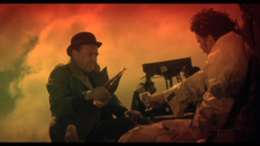 As the liner notes point out, the fact that virtually all of the lead players have died (even the younger ones) adds to the eerie, detached feeling of the film, which would play much better on a double bill with something by Jodorowsky or Lynch than a "traditional" British comedy.
As the liner notes point out, the fact that virtually all of the lead players have died (even the younger ones) adds to the eerie, detached feeling of the film, which would play much better on a double bill with something by Jodorowsky or Lynch than a "traditional" British comedy.
Thanks to its failure at the box office, The Bed-Sitting Room never received an official video release for thirty years and had to earn its reputation through word of mouth and fleeting late-night TV screenings, not to mention the deep underground bootleg videos. For reasons best known only to the movie goods, an HD master was created by MGM and 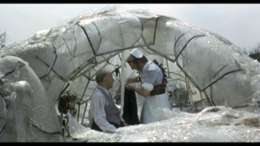 broadcast internationally on a handful of HD channels, despite the fact that they had never released it on video in any format. Thankfully the BFI then picked up the ball with a release using the same master with some additional damage clean-up, and the results are incredibly impressive. The picture quality is pin-sharp (check out the early shot of Hornden atop a mountain of shoes), doing full justice to the ambitious, texture-laden compositions, and from start to finish it's a wonderfully immersive, film-like presentation that surpasses the hi-def airing by a surprising margin. (For one thing, it's no longer interlaced.) This also marks an early entry in the company's promising Flipside series, which is dedicated to obscure and neglected cult items from Britain's filmic history. If this is any indication of what to expect, collectors have quite a few treats in store. Optional English subtitles are also included, which is helpful for some of the more rapid-fire dialogue. (As with some other BFI releases, the Blu-Ray is Region B encoded, so American consumers should find this a prime reason to invest in an all-region player since the odds of MGM ever doing this themselves on BD are very slim indeed.) As for extras, you get the original theatrical trailer and three 1967 interviews from Bernard Braden's Then and Now interview program with Lester (promoting How I Won the War), Milligan, and Cook, the last of whom unsurprisingly gets most of the highlights. A hefty booklet also contains liner notes by Michael Brooke, a Russell Campbell review from 1970, and a Lester bio by Neil Sinyard.
broadcast internationally on a handful of HD channels, despite the fact that they had never released it on video in any format. Thankfully the BFI then picked up the ball with a release using the same master with some additional damage clean-up, and the results are incredibly impressive. The picture quality is pin-sharp (check out the early shot of Hornden atop a mountain of shoes), doing full justice to the ambitious, texture-laden compositions, and from start to finish it's a wonderfully immersive, film-like presentation that surpasses the hi-def airing by a surprising margin. (For one thing, it's no longer interlaced.) This also marks an early entry in the company's promising Flipside series, which is dedicated to obscure and neglected cult items from Britain's filmic history. If this is any indication of what to expect, collectors have quite a few treats in store. Optional English subtitles are also included, which is helpful for some of the more rapid-fire dialogue. (As with some other BFI releases, the Blu-Ray is Region B encoded, so American consumers should find this a prime reason to invest in an all-region player since the odds of MGM ever doing this themselves on BD are very slim indeed.) As for extras, you get the original theatrical trailer and three 1967 interviews from Bernard Braden's Then and Now interview program with Lester (promoting How I Won the War), Milligan, and Cook, the last of whom unsurprisingly gets most of the highlights. A hefty booklet also contains liner notes by Michael Brooke, a Russell Campbell review from 1970, and a Lester bio by Neil Sinyard.